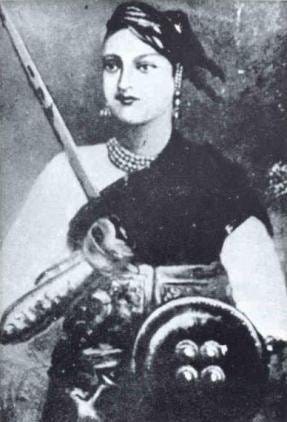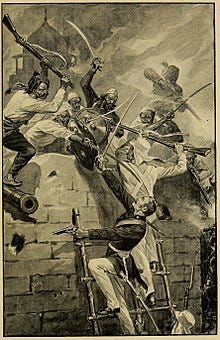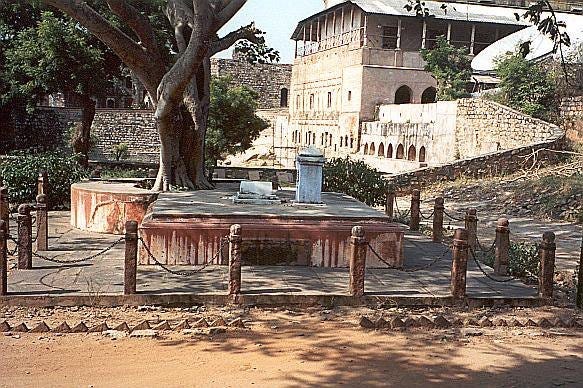Manikarnika
The Rani of Jhansi
Khub lade mardani, woh hai Jhansi wali Rani.
These immortal lines by Subadra Kumari Chauhan sum up Rani Lakshmibai of Jhansi, a legend in her own right.
A woman whose name has come to symbolize courage, independence and honor. A legend in her lifetime, Manikarnika, better known as the Rani of Jhansi, Lakshmibai.
Bundelkhand a region lying between the Indo-Gangetic plain and the Vindhyas, marked by hills, valleys, sparse vegetation and rocky outcrops. A region known for it’s harsh climate, aridity and barren spaces, an environment that has produced some of the hardiest warriors. The Chandela Rajputs who built the stunning temples at Khajuraho, Rudra Pratap Singh, who founded the princely state of Orcha, and is famous for the magnificient buildings. Veer Chhatrasal who defied the Mughals, and carved out an independent state. It was to such an illustrious lineage that the Rani of Jhansi, belonged to. Among the pantheon of greats of the 1857 revolt, she was one of the major leaders, and regarded as the greatest danger too by the British.
This woman who would defy the British, and become a byword for courage and honor, was born as Manikarnika on November 19, 1828 into a Marathi Brahmin family in Varanasi to Moropant Tambe and Bhagirathi Sapre. Her father worked for the Peshwa of Bithoor, who bought her up like his own daughter, called her Chabili. She was educated at home, and more independent in childhood than others of her age.
She learnt horse riding, archery, sword fighting as well as mallkhamb, growing up with her childhood friends Tatya Tope, and Nana Sahib, who happened to be her cousin too. She loved horse riding, and it’s believed that sbe once managed to beat Nana Sahib himself, on her horse. No mean feat as Nana Sahib was regarded as one of the finest horse men then. Sarangi, Pavan, Badal were her favorite horses, and it’s believed she rode Badal during her escape from Jhansi.
Jhansi originally was the stronghold of the Chandela rulers and was called Balwant Nagar. Losing it’s prominence, it however recovered it’s past glory under Raja Bir Singh Deo of Orchha, who also constructed the famous fort there. When Baji Rao rescued Veer Chhatrasal from the Mughals, Jhansi was one of the territories given to him as a mark of gratitude. The city developed under the Peshwa rule, and Naro Shanker the Subedar, extended the fort, built many other structures too. The Newalkar clan played a crucial role in governing Jhansi, including revenue collection, as well as the temples there.
At the age of 13, Manikarnika was married to Gangadhar Rao Newalkar , the Maharaja of Jhansi in whose court her father worked and she was given the name of Lakshmibai. The Maharaja was known for his statesman like qualities, a wise administrator and had a fine library of Sanskrit manuscripts. When their 4 month old son Damodar Rao, died, the Maharaja adopted his cousin’s son, Anand Rao, whom he named after his own son. As per Hindu tradition, Damodar Rao was the legal heir, however the British refused to accept him as one.Gangadhar Rao, requested Lakshmibai to take care of Damodar Rao, when he passed away, and the adoption was done in presence of a lawyer.
Lord Dalhousie however refused to accept Damodar Rao's accession as per Doctrine of Lapse, and decided to seize Jhansi.Basically the Doctrine of Lapse was signed between East India Company and Princely States. As per this if the ruler of a princely state died without a natural heir, the East India Company cud annex it.Satara was the first princely state to be annexed by the East India Company under the Doctrine of Lapse this way.
The British authorities confiscated the state jewels of Jhansi and she was asked to leave the fort and move to Rani Mahal. Laxmibai was however not willing to give up Jhansi, she assembled a volunteer Army, and strengthened the defenses. Women were also given military training under Lakshmibai, and soon many other warriors gathered under her.Ghulam Gaus Khan, Dost Khan, Moti Bai, Dewan Raghunath Singh, Jawahar Singh were those who rallied behind Jhansi Lakshmibai.
She was initially reluctant to join the 1857 Revolt, and Jhansi remained relatively calm for some time. However Jhansi was attacked by Orcha and Datla, the Company's allies, whose main aim was to take over the kingdom and divide it. And when British troops led by Sir Hugh Rose attacked Jhansi on March 23, 1858, she had no hesitation in plunging into the revolt. Prior to that, Lakshmibai appealed to the British for aid against the attacks by Orcha and Datia, however they did not respond. Lord Dalhousie felt that Laxmibai was involved in a massacre of European families in Jhansi earlier by sepoys, refused to aid her.
"We fight for independence. In the words of Lord Krishna, we will if we are victorious, enjoy the fruits of victory"
The British laid siege to Jhansi on 23rd March 1858 and began to bombard the fort, she however refused to surrender. Lakshmibai proved to be a true leader, rallying her troops, moving from one defense to another, keeping up the morale of people. The women's unit raised by Lakshmibai was also active supplying arms and food to the soldiers.
"If defeated and killed on the field of battle, we shall surely earn eternal glory and salvation"
In the meantime Lakshmibai made an appeal to Tatya Tope, who rushed to her defence with a force of 20,000. However his men were no match for the better trained, better equipped British forces, who defeated them on the field. Finally on March 31st, Jhansi could no longer hold out, and the British managed to break the 3 day siege, enter the fort.Though the British entered Jhansi, they encountered determined resistance, the residents refused to surrender without a fight.The residents of Jhansi engaged in continuous street to street fighting with the British soldiers and stubbornly resisted them.
Rani Laxmibai managed to escape from Jhansi with Damodar Rao on horseback,and left to Kalpi, where she met Tatya Tope. Her adopted son strapped to her back, on the horse back, Lakshmibai jumped at this point to escape the British. This is located at Jhansi Fort.
This is the memorial dedicated to her 3 trusted warriors Ghulam Gaus Khan, Motibai and Khudabaksh.
And this is the Bhavani Cannon at Jhansi Fort, which was operated by Lakshmibai's trusted warrior Moti Bai.
After the British forces defeated them at Kalpi, Rani Laxmibai along with Tatya Tope, escaped to Gwalior. Along with Tatya Tope, she captured Gwalior, the forces of the Scindia switched over to the rebel's side.Gwalior Fort was now under the rebels ,who proclaimed Nana Sahib as the Peshwa of a renewed Maratha dominion.
June 18, 1858, the final battle of Lakshmibai's life, against the 8th Hussars at Kotah ki Serai near Phool Bagh area of Gwalior. Donning the clothes of a warrior, Lakshmibai rode into the battle, her final one against the British forces.The Hussars charged into the Indian forces, killing many of them, and continued right up to the Phool Bagh area. As per accounts Lakshmibai was grievously wounded by a sabre, and then finally fired upon by a soldier. Gwalior was captured after 3 days, by the British, Lakshmibai was cremated somewhere near by the local people.
The best tribute to Lakshmibai was paid by Sir Hugh Rose who called her the most dangerous of all the Rebel leaders. Her memorial is located in Gwalior's Phool Bagh area, where she fell fighting to the last. Lakshmibai's sacrifice did not go in vain, she would inspire and motivate a whole generation of freedom fighters. When Netaji Subash Chandra Bose raised the Indian National Army, he named the women's unit in honor of Rani of Jhansi.
बुंदेले हरबोलों के मुँह हमने सुनी कहानी थी, खूब लड़ी मर्दानी वह तो झाँसी वाली रानी थी।
One great tribute to Rani Lakshmibai of Jhansi by Subhadra Kumari Chauhan, sums it all up.
Sources






